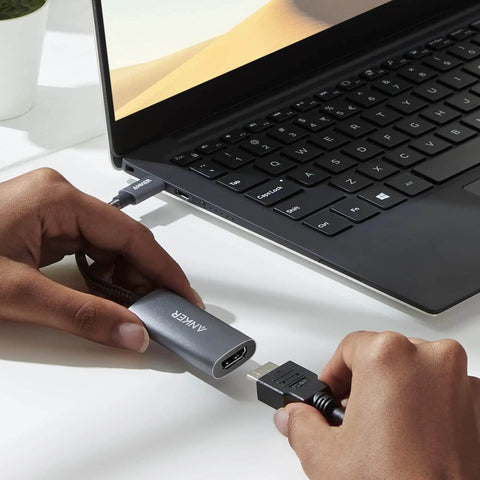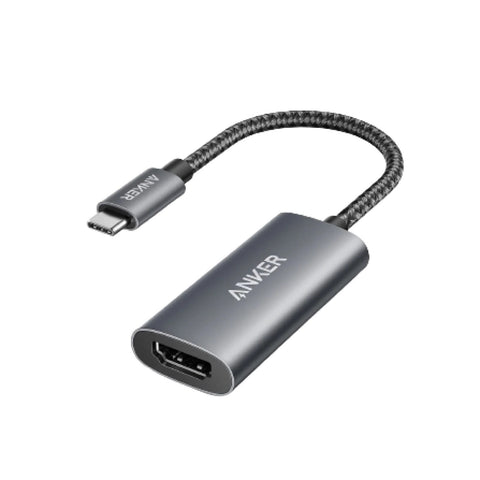
How to Use USB-C to HDMI Android: Find the Answer
In this age, where technology is interwoven with everyday life, knowing how to make the most of your gadgets and accessories is increasingly useful. Possessing a USB-C to HDMI adapter substantially expands your Android mobile’s potential, enabling a connection to high-definition displays such as televisions, monitors or projectors. This article offers a step-by-step approach to using USB-C to HDMI on your Android device, while also providing practical tips to choose the ideal adapter that meets your needs.

What Can You Do with a USB-C to HDMI Adapter for Your Android?
A USB-C to HDMI adapter allows you to link an Android phone to an HDMI display, such as a television, monitor or projector. This connection not only expands the functionality of your mobile device but also creates a more engaging and practical experience for both leisure and work.
Key uses for a USB-C to HDMI adapter include:
- Screen Mirroring: Present your mobile’s screen on a larger display so that you may share films, images, and presentations with colleagues or family. It is particularly handy when you wish to show holiday snapshots or stream videos from platforms like YouTube.
- Extended Workspace: By connecting your mobile to an external monitor, you can utilise it as a supplementary display for productivity applications, such as word processors, spreadsheets and even design programmes, thereby improving efficiency.
- Media Centre Conversion: Transform your phone into a media hub and watch your preferred streaming services, including Netflix, Disney+, Hulu or Amazon Prime Video, on a bigger screen. This enhances the viewing experience in a comfortable setting.
- Large-Screen Gaming: Enjoy mobile gaming on a larger display. This opens up fresh possibilities and makes gameplay more immersive, enabling friends to share in the excitement of the action.
- Live Presentations: Deliver presentations straight from your Android phone, ensuring that your work is showcased with clarity and a more engaging visual experience for your audience.
How to Use USB-C to HDMI Adapters on Android?
Below is a clear, sequential guide on how to set up and use USB-C to HDMI adapters with your Android device:
Verify Adapter Compatibility
Before buying or utilising a USB-C to HDMI adapter, confirm that your Android phone supports video output via its USB Type-C port. Inspect the device’s specifications for indicators like DisplayPort Alternate Mode (DP Alt Mode) or MHL support. Additionally, review the adapter’s product details to ensure it is fully compatible with Android devices. If you remain uncertain, consult your mobile’s manufacturer.
Connect the Adapter, HDMI Cable, and USB-C Port
Insert the USB-C end of the adapter into the USB-C port on your Android device. Attach an HDMI cable to the adapter’s HDMI end and then connect the other end to an HDMI-enabled display, for instance, a television, monitor or projector.
Configure Your Android Device
Once the connection is established, your device should automatically detect the external display and mirror its screen. Should the mirroring not commence, perform the following steps:
- Swipe down from the top of your screen to access the notification area.
- Look for a notification concerning the external display or HDMI connection and select it.
- Choose the appropriate setting to activate screen mirroring or an extended display mode.
If no such notification appears, navigate to your device’s settings:
- Open the Settings app and locate the Display options (or search for “Display”).
- Identify settings associated with HDMI output, screen casting or external display modes.
- Activate the preferred output mode to initiate mirroring or an extended display.
Adjust Display Settings (Optional)
Once your Android device is linked to the external display, you might wish to modify the output resolution or aspect ratio for optimal performance. To do this:
- Return to the Display settings on your Android device as outlined above.
- Find and adjust options related to external display settings or screen resolution to secure the best possible quality for the connected screen.
How to Choose the Right USB-C to HDMI Adapter?
Selecting the most appropriate USB-C to HDMI adapter requires consideration of several factors:
- Compatibility: Always verify that the adapter is suitable for your devices. Examine the types of USB-C and HDMI ports on both your mobile and the intended display, ensuring the adapter meets these specifications.
- Resolution Support: Evaluate the maximum resolution the adapter can deliver. Should you plan to project to a 4K display, select an adapter that supports 4K resolution reliably.
- Additional Ports: Some adapters provide extra functionalities, such as USB ports, SD card slots or power delivery options. If these features are necessary for your use, a multi-port adapter may be the best option.
- Price Considerations: Although more economical choices might seem appealing, they may not offer the performance or durability required for everyday use. Striking a balance between quality and cost-effectiveness is essential.
- Power Delivery: For devices that charge via USB-C, an adapter featuring Power Delivery (PD) can prove very convenient, as it allows simultaneous charging and data transmission.
- Quality Assurance: Opt for brands with positive customer reviews and robust warranty offerings. The construction quality significantly affects both durability and overall performance.
Anker remains a trusted name that consistently fulfils these criteria. Known for producing high-calibre tech accessories, Anker offers a variety of USB-C adapters that have earned widespread acclaim. Two noteworthy products include:
Anker 310 USB-C Adapter (4K HDMI)
The Anker 310 USB-C Adapter (4K HDMI) leverages cutting-edge technology and is trusted by millions globally. This robust, lightweight adapter–fashioned from durable aluminium–delivers vivid 4K video streaming via any HDMI-equipped display, simply by connecting your device without the need for additional installation. Its reinforced braided nylon casing ensures it withstands daily use with ease.

Anker 518 USB-C Adapter (8K HDMI)
The Anker 518 USB-C Adapter (8K HDMI) offers crystal-clear video output at 8K@60Hz or 4K@144Hz. With its effortless plug-and-play functionality, it converts your laptop’s USB-C port into an HDMI interface without any complicated setup. Being HDCP-compliant, it guarantees smooth playback of encrypted content and is universally compatible with nearly all USB-C devices, connecting effortlessly to televisions, monitors and projectors.

Conclusion
Connecting your Android device to larger screens using a USB-C to HDMI adapter can significantly enhance your digital life. Whether you intend to stream films, utilise productivity applications, or present work projects, understanding how to use USB-C to HDMI on your Android device is invaluable. It goes beyond merely choosing an adapter; it opens up a host of new possibilities in terms of productivity, entertainment and overall connectivity.
FAQ
Why is my USB-C to HDMI not working on my Android phone?
Your USB-C to HDMI adapter might fail to function if your Android device does not support video output via its USB-C port (look for DisplayPort/HDMI Alt Mode support). It is also advisable to verify that both the cable and adapter are fully compatible and in good condition. In some cases, restarting your device or updating its firmware can resolve connectivity issues.
How do I connect my Type-C phone to an HDMI television?
To connect a Type-C phone to an HDMI television, first ensure that your device supports video output through its USB-C port (via DisplayPort or HDMI Alt Mode). Then, simply use a USB-C to HDMI adapter. Insert the adapter into your phone, attach the HDMI cable to both the adapter and your television, and finally select the appropriate HDMI input on your TV to begin screen mirroring or extending your display.
How do I mirror my Android to my TV with USB-C to HDMI?
To mirror your Android screen via USB-C to HDMI, connect the USB-C end to your phone and the HDMI cable to your TV. Ensure your TV is set to the correct HDMI input. Most modern Android devices will automatically display the phone’s screen on the TV without additional settings.














